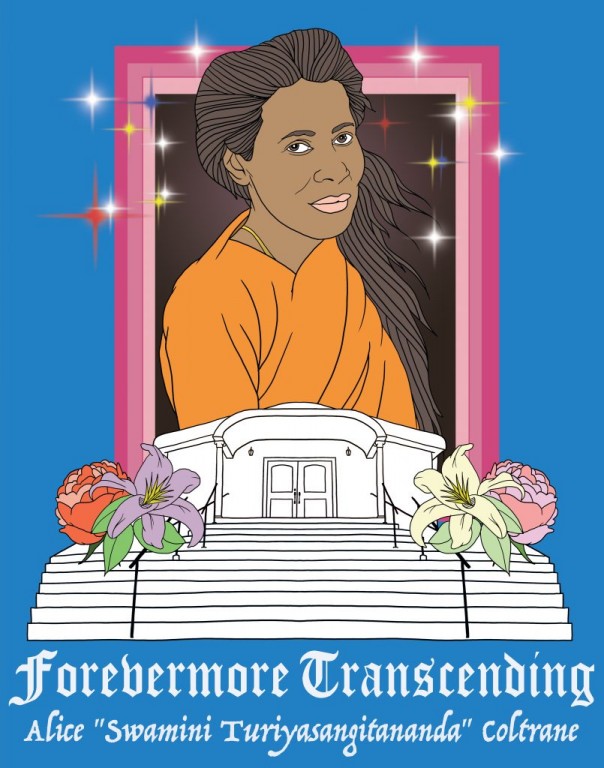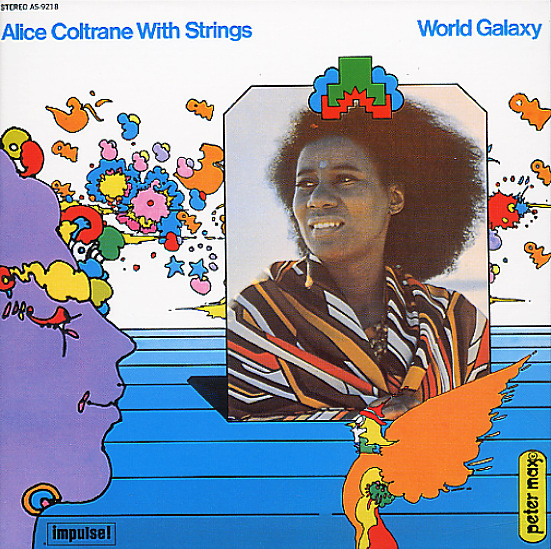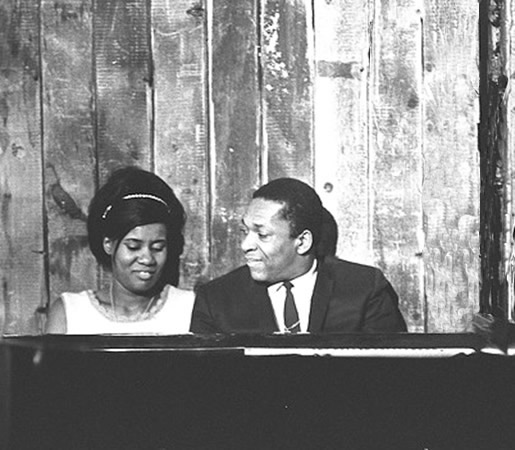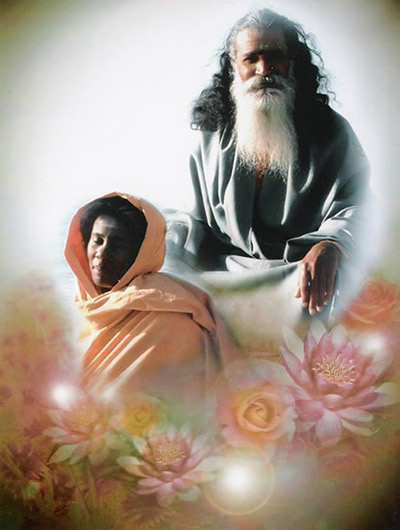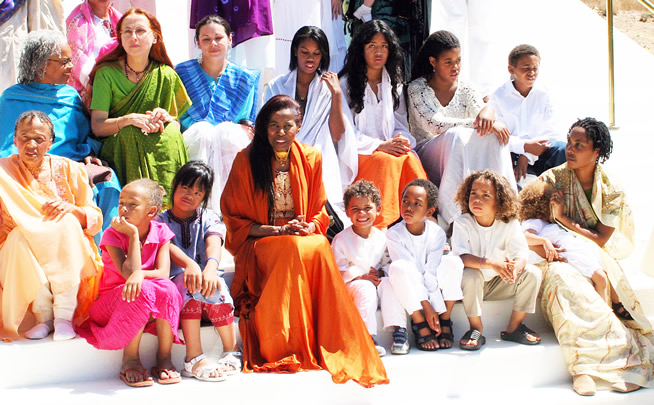Inner Space is the Place
Over 14 years ago, dublab founder Mark McNeill (also known as Frosty) encountered a high spirit on the cover of an album from 1972. Manifested in the form of Alice Coltrane, she was swathed in robes and framed by the figures brought to life by psychedelic artist Peter Max for her record, World Galaxy (1972, Impulse! Records).
Album cover art, World Galaxy
“When I dropped the needle and heard the music my world was blown apart,” he recalls. “Between the newly shattered pieces Alice injected a shimmering light. Her string arrangements, lush and majestic, dissolved at points, giving way to intimate moments that burned and swung then swelled skyward again.”
What began as a crate digger’s revelation, was ignited further, with a friend’s (Zach Cowie, Turquoise Wisdom) introduction to her little known ashram records- four albums she self-released through her Sai Anantam Ashram in Agoura Hills, California between 1982-1995.
What he heard inspired him to forge a path of deep exploration of an artist, musical and spiritual figure, guru, wife, widow, mother, aunt, transcendent person- who encapsulated both the super and the human. Years later, this exploration resulted in a deep masters thesis examination of Alice Coltrane through the words and music of those who knew her best.
Forevermore Transcending: The Ashram Albums of Alice “Swamini Turiyasangitananda” Coltrane, Frosty’s recently released audio documentary is a kalaidoscopic exploration of Alice ‘Swamini Turiyasangitananda’ Coltrane’s devotional music, through interviews with family members, students, musical collaborators and scholars. We took some time to talk with him about the woman, artist and the process of this storytelling.
As a person with a deep knowledge of Alice Coltrane’s work, what was it that drew you to this portion of her musical output specifically?
My history with her music- being a music lover and explorer and radio DJ- you are always seeking new sounds. Those are the things that pull me in- that’s what makes a life in music exciting- to know that there’s always something around the corner – to know that there’s always new music being made.
To stumble upon something like this, is really special.
I heard this music- and I started digging around for more of it- there were little bits and pieces online- but one of the most obvious was her ashram.
So you know, I said that this is in our town essentially. I jumped in the car the next Sunday – and went to visit the ashram and attended a service, met some of the folks- discovered that this ashram she had started in the 70s continued to exist.
“I remember the ashram as kind of a journey. You know, you were going to the magical place, it had that feel to it. You know, you were going there on a magical Sunday.” –Flying Lotus (Alice Coltrane’s great-nephew)
I was able to dig up more of the music and wrote an article and made a radio mix of the music- about 5 or 6 years ago. It ended up being one of those things i put up and it seemed to resonate with- for example, Brian Eno tweeted about it.
I realized that when people heard this music, although it was based on ancient vedic texts- and in a way so different, and so specific to her world, it also had this resonance amongst a larger audience and so I just continued to explore what the music was all about.
It was actually one of the reasons that I wanted to pursue this masters degree, was to be able to take time out to have kind of a more thoughtful examination of these records.
Obviously, Alice was married to John Coltrane and her musical / spiritual journey seemed to take a turn away from the mainstream following his passing. Do you feel like his death is something that drew her more directly towards this spiritual path?
He [John Coltrane] was already exploring eastern meditation, and by the time he and Alice met, he had read Autobiography of a Yogi– he was doing his exploration. When they met- they kind of found common ground over this.
They really intensified their practice of meditation and they were exploring this kind of world- also while having a family and in the few years when they were married- the four years- they had three sons (she already had a daughter from a previous marriage), a family of 4 young children.
That’s something her daughter always says- is that her mom was human and superhuman in a way.
“This is a black woman from Detroit. She had an ashram in the westernized part of the world, became a guru, and left quite a legacy.” –Michelle Anne Coltrane (Sita)
She was the realest of the real. In many ways – she walked the walk and talked the talk. She was someone who was very principled and very serious – but always human. She made sure the kids did their chores, she was Mom. But she was also something kind of greater than that.
So they were doing this thing, and he passed away which was really tragic, and threw her into turmoil.
On one hand you could look at it and say, this is a woman having a nervous breakdown. she has lost the love of her life- she has 4 young children and her whole life has been shaken up.
I think that is also true- that when you are going through such a loss and a tragedy- so she was obviously still seeking- but it wasn’t until her friend Vishnu Wood invited her to come to a talk by Swami Satchidananda- who had been brought to New York by Peter Max.
So she went to attend this talk and the lightbulbs went on and she realized “This is the path that I’m kind of going down” and she really befriended swami, they became super close and she started traveling down that path.
Her recollection of this time is that she’s traveling through the universe. She understood that people didn’t understand what she was going through- she would fast, and go through sonic bombardment, the deepest most intense- earth shaking universal sounds.
In her world- in the vedic tradition- Om was the first sound in the universe, Om created the universe. So she was part of this sonic theology- she started to experiencing these kinds of sounds- basically God showing her, exposing her to these things.
She was also astral traveling through the universe and basically being brought to the beginning of time and experiencing the start of the universe.
All of these things that come through her meditation.
To say that she was on a spiritual path is very accurate and to say that it was kickstarted by Johns’ death is also very accurate. She went full speed in her spirituality but she also had these tribulations and came out the other end and started making records.
Alice and John Coltrane, alicecoltrane.org
Astral traveling through the universe! How did she then shift from making her solo records into building the Ashram?
She was going deeper and deeper into spiritual studies and in 1973 she basically was going to India with Swami Satchidananda.
Her spiritual studies were becoming more important than releasing albums- and so in the early 70s, she donned these saffron robes and she was anointed by God.
Alice Coltrane and Swami Satchidananda, alicecoltrane.org
She recalls this whole experience as wearing these white robes and God pouring the color of saffron into the robes, and basically kind of reaching this point of self realization after deep studies in India. One of the things people don’t know- is that she was a fluent Hindu speaker.
In the 70s, she was asked to come to speak at a place called the One Mind Temple – in San Francisco, which morphed into the Church of Saint John Coltrane. She went to speak to them and she basically founded her ashram called the Vedantic Center at the One Mind Temple.
They were studying yoga, meditation, they were feeding the homeless, it was very connected to the African American civil rights, social rights, self-empowerment movement.
She ended up bringing this group of devotees together, started it there and moved it down to Southern California, because she had just moved from New York and started the ashram at her house, in the valley, in Woodland Hills. A couple years later she got this land in Agoura Hills and opened the ashram there in 1977. In February of 1983, the center moved to the (then) Shanti Anantam Ashram and in 1984 Shanti Anantam re-emerged as Sai Anantam.
At that point, she fully devoted herself to her spiritual life, and people thought she had completely retired from music. She didn’t put out a commercial album until 2004, Translinear Light.
There was a period from 78-2004 that people (26 years) that people just thought she had retired – but she was actually playing music more than ever, but in a spiritual context- at the ashram.
Alice Coltrane Turiyasangitananda with some of her students and their families, alicecoltrane.org
How were people gaining access to the records and what was her intention with pressing them if not for commercial release?
The very first of these records was Turiya Sings– it was totally a surprise to her devotees.
She told her students to meet me here at this time- on the ashram grounds- at 4am (this was traditionally an early meditation hour) and asked them all to bring a portable cassette player.
She handed out these tapes- blank, they didn’t know what they were- and asked them to find a quiet place and listen to it. so they all went off and put the tapes in and listen to it and they were blown away but also confused.
Many of them didn’t know who was singing at all, many of them thought it was a man- although they were intimately familiar with her voice, they had never heard it in this kind of context- that was the first time she shared that music with anyone.
She pressed this music up and she made it available- but she was of the mindset that it’s important for people to come to things- and John had this idea too- it means more when you come to it and you can discover it.
One of her other big things was when the time is right, the time is right and so she was never in a rush. The records were available, but mostly circulating within the spiritual community – pressed in small numbers and never meant to be pop hits.
They were meant to be spiritual aids and spiritual inspiration, and so that’s why they were kind of unheard for so long.
Up to this point, she’d been known as an accomplished multi-instrumentalist, but not necessarily vocalist. It seems like she’s using this channel- she’s finding her voice in a very literal way – what do you think it was that allowed for this to become the primary vehicle for her message?
She would say, the voice is the soul reflection. Especially in Turiya Sings, the idea of soul reflection is pretty accurate, and so this was just a very personal kind of devotional body of work. It was her having this personal connection to God, but be able to record it, share it with others so that they could benefit from it.
The interesting thing is that she’s doing this totally on her own terms, which is pretty cool so you’ve got somebody who has a spiritual history / legacy. She grew up playing piano and organ in the gospel church and she played every week in the gospel church and she talked about her early experiences of playing in the church and seeing people totally fall out and go into this boom- spiritual state where the spirit overtook them and that’s something that happens- and in religious celebration- she was kind of scoring that experience- she had experience playing those dynamics.
She was part of a vocal group called The Premiers- she had sung in the past. These are things that had always been a part of her but in a new context, and the fact that she was taking ancient vedic text and doing her own arrangements of them.
These were her own specific arrangements- but thousands and thousands of year old texts and she’s telling these stories of god in different forms, of hindu dieties- and these are stories that are ancient but she’s putting them into new context, into new musical settings and putting her own twist on it and adding her own personal history.
But you know- she’s from Detroit- she’s a Detroit church girl- so you know – it’s gonna sound different.
She’s a female, African American, avant-garde jazz musician, spiritual guru, mother, all of these things that any one of those things in 20th century american society can be a challenging identity.
So she was all of these things wrapped into one and more- but also had sidestepped – she had extracted herself from a space of criticism – she was concerned with other matters.
“…George Clinton and Sun Ra are pointing to outer space as a metaphor for where marginalized people can be authentically themselves, Alice is pointing to inner space. They’re looking to the stars; she’s looking to the universe inside of her.”–Varun Soni, Dean of Religious Life at the University of Southern California
One of the things that came out in research- George Clinton and Sun Ra- they were looking for liberation in outer space and Alice was seeking it in inner space.
So by the idea of self realization and self determination and liberation so she could be her own person in the universe and liberate herself from all of the static that was out there.
One thing that kept returning in these interviews was this idea of her as both transcendent spiritual guru figure, and just an earthly being who does normal things. I loved so much the visual of her testing a synth in Guitar Center.
That’s the human element. I was talking to her daughter the other day, Michelle, and she was like- “My mom would like eat a Baby Ruth candy bar. She was a person!”
Her sister Marilyn- who is also a phenomenal person, she wrote “Love Hangover” for Diana Ross. She was a Motown songwriter and musician from Detroit and moved out to California when Mo West moved out here. A phenomenal soul artist and disco artist. She would drive Alice to the ashram on Sundays because they lived really close to each other.
It would be really quiet on the way, she wouldn’t speak to her sister much because she was preparing for her satsang- her sermon- so it was quiet.
And then they would go and have this celebration and chant and play music and spend time together and then they would be super charged after that and then they would leave and be giggling and making jokes with each other.
Just being sisters and they would go out and Alice would want to go get ice cream cones- so they would go and get ice cream. But she didn’t take these robes off- this was the real deal. the spiritual part of her was not a front, but also the human part of her was still there.
Support dublab by donating here during their annual pledge drive!
Artwork for Forevermore Transcending: The Ashram Albums of Alice “Swamini Turiyasangitananda” Coltrane above by Jess Rotter
Quotes excerpted from Forevermore Transcending: The Ashram Albums of Alice “Swamini Turiyasangitananda” Coltrane
A Thesis Presented to the FACULTY OF USC GRADUATE SCHOOL UNIVERSITY OF SOUTHERN CALIFORNIA by Mark McNeill, copyright 2016
